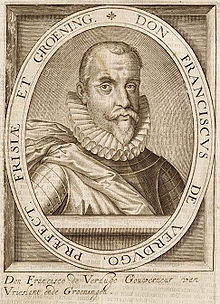Battle of Noordhorn
In 1580, during the Eighty Years' War, the Dutch stadtholder of Groningen, George van Lalaing, Count of Rennenberg, though having been appointed by the rebellious States-General, shifted his allegiance to the Spanish government, held at that time by Don Alexander Farnese, Prince of Parma.
[2] Verdugo, born in Talavera but raised amongst the Flemish and married to a daughter of the later governor-general of the Netherlands, Peter Ernst von Mansfeld, began his career as a simple soldier, but rose through the ranks to become a colonel.
[3] He was considered by the historian Charles Maurice Davies "a leader of eminent skill and ability",[4] and was promoted to the post over other candidates such as Colonel Maarten Schenck van Nydeggen, whom Farnese had earlier sent to relieve Rennenberg and had dealt a serious defeat to a Dutch army at the Battle of Hardenberg, on 17 June 1580.
[6] While mustering his infantry in the village of Kerpen, Verdugo learned that the Dutch rebels were leaving a company of German reiters – a type of armoured cavalry armed with pistols – in Cologne under a rittmeister called Adam von Langen.
[7] As he lacked cavalry or pikemen and it was reported by Spanish agents that von Langen was angry because he had been paid by the Dutch with false coins, Verdugo managed to convince the rittmeister to escort his arquebusiers to Groningen.
There, Verdugo was met with a mutiny, which he ended by distributing 40,000 escudos amongst the mutineers, disbanding an undisciplined German regiment, and giving license to two companies of men-at-arms to join Farnese's army in Hainault.
During 1580, the Dutch forces fighting Rennenberg in Friesland had failed to prevent him from taking the towns of Oldenzaal and Coevorden, but in December, under the leadership of the English Colonel John Norreys, a veteran soldier with experience in the Netherlands and Ireland, they had succeeded in relieving Steenwijk from a Spanish siege.
[1] Norreys, appointed "Master of the Camp" by the Dutch States-General, harassed the Spanish army during the winter of 1580–1581, forcing Rennenberg to lift the siege and withdrew in February.
Though England was not officially at war against Spain, Queen Elizabeth I was playing a complex diplomatic role to keep the Dutch revolt alive,[11] and this included sending troops to the Netherlands under the guise of "volunteers", but factually maintained by the English crown.
[17] The Spanish army, led by Francisco Verdugo, with Lieutenant-Colonel Johann Baptista von Taxis as second in command, was deployed before the village of Noordhorn and behind broken ground with only one access point that was covered by a wide ravine and flanked on its left by a series of muddy ditches.
[19] The left consisted of two cavalry companies (Famiano Strada names German reiters under Wolfgang Prengier,[19] while Alonso Vázquez mentions Albanian horse under Captain Tomas Frate and Walloons under Baron de Bievres)[21] plus a battalion formed by the second half of Verdugo's foot regiment.
[17] The Anglo-Dutch army under John Norreys and Count William Louis of Nassau-Dillenburg was formed by 30 companies of foot – 11 English and Scottish flags from the regiments of Norreys and Colonel Thomas Morgan, and 19 Dutch, Frisian and Walloon flags – plus four cavalry companies under Captains Hendrik van Eck, Goor, Elleborn and Roger Williams, the latter of English cuirassiers.
Monsieur de Villers' harquebusiers and Verdugo's lances under Corporal Mendo ignored their general's orders, and charged against the Dutch cavalry, which drove back them "broken and disrupted".
[21] The English infantry, upon Norreys' order, charged the Spanish foot on the right, gaining more ground despite the difficult advance, and pushing back Verdugo's Walloons to Noordhorn.
[26] Once he had recovered, Verdugo massed some cavalry and completed the Anglo-Dutch defeat by destroying an English troop which, trying to save the flags, fled across a field towards the Niezijl canal.
[30] The day after the battle, the Spanish army's German regiments, induced by Captain Jean van der Cloester, mutinied again in their quarters, claiming that they had not received their monthly pay.
[31] Verdugo sent Captain Pedrosa to take news of the Spanish victory to Farnese and, having refreshed his troops, aimed to capture the Niezijl fort with his Walloon regiment, his four cavalry companies and a few volunteers from among the German mutineers.





